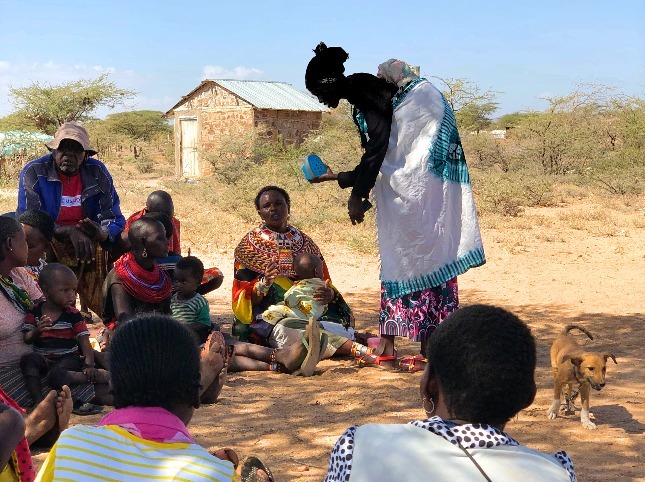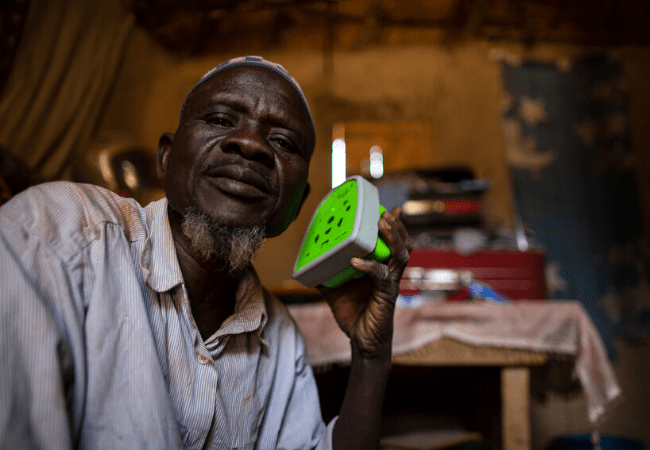Community radio, digital tools, and community mobilization approaches to COVID-19 response
by Danielle Henry
This story originally appeared on Amplio.org on March 27, 2020.

USAID’s Afya Timiza project uses the Amplio Talking Book train and support community health volunteers in Samburu County.
In March, the World Bank’s Community-Driven Development team consulted Amplio senior program manager Ryan Forbes Morris on ideas and communication strategies for a COVID-19 response in remote regions where there may not be internet. Here are some considerations Morris recommends to strengthen outreach, prevent the spread of infection, and address emerging public health issues that may impact vulnerable populations in rural areas.
1. Leverage existing communication channels
Work with community radio partners and local experts to create and disseminate content. Use existing health hotlines or SMS or IVR channels to answer questions and get your message out.
2. Partner to align COVID-19 response key messages
If you’re planning to create and disseminate content as part of your COVID-19 response, partner with other organizations, government ministries, and local influencers that are working in the same communities—such as district health directors, assemblymen, tribal chiefs, and religious leaders—to align your messages. Make sure information is consistent so that people don’t get confused.
3. Identify and promote credible sources
There’s a lot of information (and misinformation) going around, so it’s important to connect people with credible sources. Community media outlets also can have trouble accessing credible sources to inform their content production. To address this, UNICEF Ghana worked with the Government of Ghana and the private sector to develop the Agoo mobile platform to educate people about cholera and ebola outbreaks. The World Health Organization is now sending COVID-19 messages through WhatsApp. These are two examples of credible sources of information available on widespread platforms.
4. Create community feedback loops
There are various ways to create feedback loops between communities, stakeholders, and service providers. This will assure that your interventions are relevant to the people that you’re trying to serve. If you’re working with local media outlets for COVID-19 response, call-in shows and live debates are a great way to engage the community and elevate people’s voices. Health and agriculture sector stakeholders and decision makers could participate to address questions and concerns faced by listeners. SMS logs or hotline-based interventions can be used to monitor challenges and successes of target communities.
5. Go the extra mile to reach vulnerable populations
Think about what you might do differently to reach and address the challenges of some of those most vulnerable demographics, including women, children, people with disabilities, etc. For example, how will you reach those who aren’t able to access the internet or a mobile phone, including women? What about those who can’t read?
6. Link community media and district health experts
Community radios have the trust of their communities and can develop culturally appropriate messaging in local languages. Encourage more information sharing and collaboration between community radio journalists and district-level health and agriculture experts. This will align messaging around prevention and access to essential services. Furthermore, sharing information can collectively create solutions to address barriers and challenges faced by community members.
7. Develop a long-term approach to strengthen community health systems
Think about long-term approaches for knowledge sharing and prevention strategies at the community level. Contact Amplio to set up a free consultation on how to incorporate Talking Books into a new or existing public health program. Learn how Talking Books can be paired with other interventions and communications channels to maximize your impact. Amplio’s technology makes it easy to update Talking Books in the field and add messages that cover emerging issues, like COVID-19, and collect usage data and user feedback.
Prior to joining Amplio, Ryan Forbes Morris specialized in communication for development at IREX. He led the community radio component of USAID’s $14.9M Mozambique Media Strengthening Program. In addition, he managed a project funded by the World Programme to link community radio journalists with health and nutrition officers around production of social and behavior change content in partnership with the Mozambican government and USAID’s Maternal and Child Survival Program.
Morris is an international development professional with more than 10 years of experience leading communication for development (C4D) projects. As senior program manager at Amplio, he leads business development and consults on Talking Book program design and C4D strategies. Connect with Morris on LinkedIn or get in touch at ryan@amplio.org.
